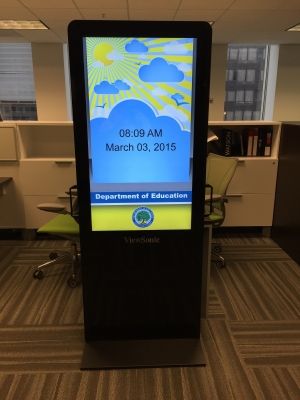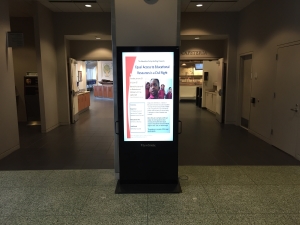- The U.S. Department of Education is rolling out a digital signage network powered by Navori Labs, delivering content to digital display screens throughout its Washington, D.C. headquarters. The department will extend the network to locations in Dallas and Denver later this year.
A digital signage display informs employees about upcoming office events.
The Department of Education facility services team selected the Navori QL digital signage engine following an extensive evaluation of several systems. Program manager Joy Jordan pointed to the QL platform’s multi-user capability as offering significant value for departmental communications, along with a simple user interface.
“We wanted full-service digital signage software that would be simple enough for casual users, but robust enough to go department wide,” said Jordan, who works for the Office of Management, Department of Education. “We needed a tool that could be used by a wide variety of people.”
Jordan stressed the importance for different users to easily build playlists targeted to specific screens, and how that creates a unified communications experience for the department.
“Navori Labs allows us to have our core content for the entire network, while regional users can mix in their own content without concern of delivering to the wrong screens,” she said. “This will be especially important as we expand the network to other locations. Our regional offices will receive timely and pertinent information, and feel that they have a real buy-in with this network.”
VisualPoint, a full-service IT consulting company working with the Office of Management, is tasked with building out the signage network for the Department of Education. According to Pedro Perez, president, the Navori Labs QL digital signage engine is built for quick deployment, with limited installation requirements at new locations.
“Beyond hanging up screens, extending the network means plugging in a player and assigning an IP address,” Perez said. “Once online, we can easily segment a new population of users that can control its own displays, with defined user protections. We’re still exploring all the different configuration options, including by group, by building, by region, and the different variations within those options.”

Digital signage displays can be used for multiple purposes around the office.
To date, the QL digital signage engine is reliably delivering native video, graphics and data to screens in high-traffic areas at headquarters, including lobbies, the cafeteria, and waiting areas by the elevators.“Digital signage really changes the way we communicate across the department,” Jordan said. “We previously relied exclusively on our website, e-mail, and paper fliers, and too often people weren’t receiving important information. Everyone likes the idea that they can look at a screen and get information as they wait by an elevator. These screens are our central point of contact now. Employees can take in the information and keep moving.









